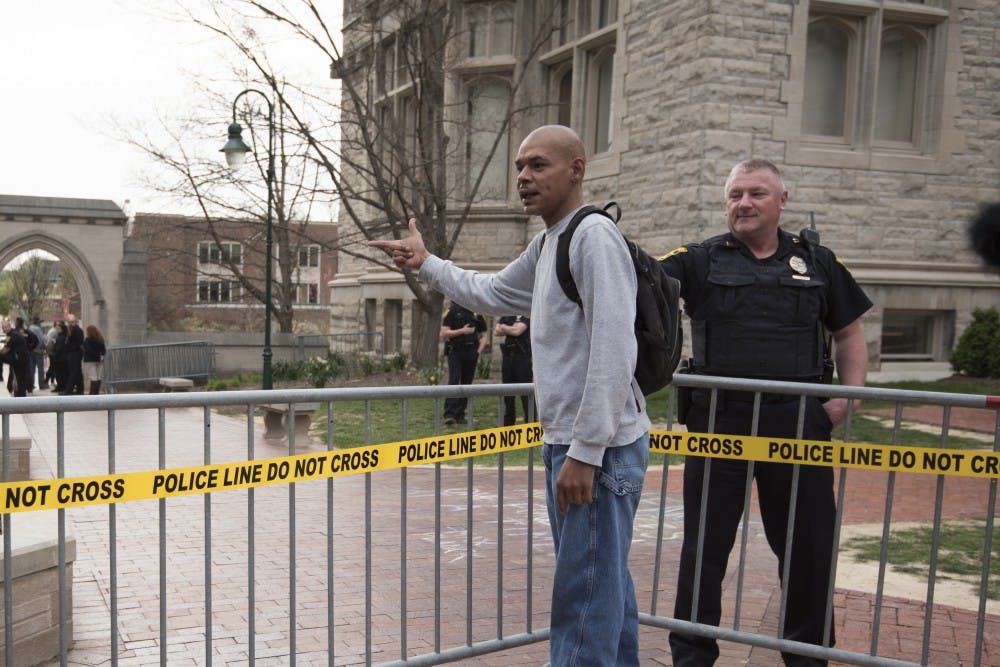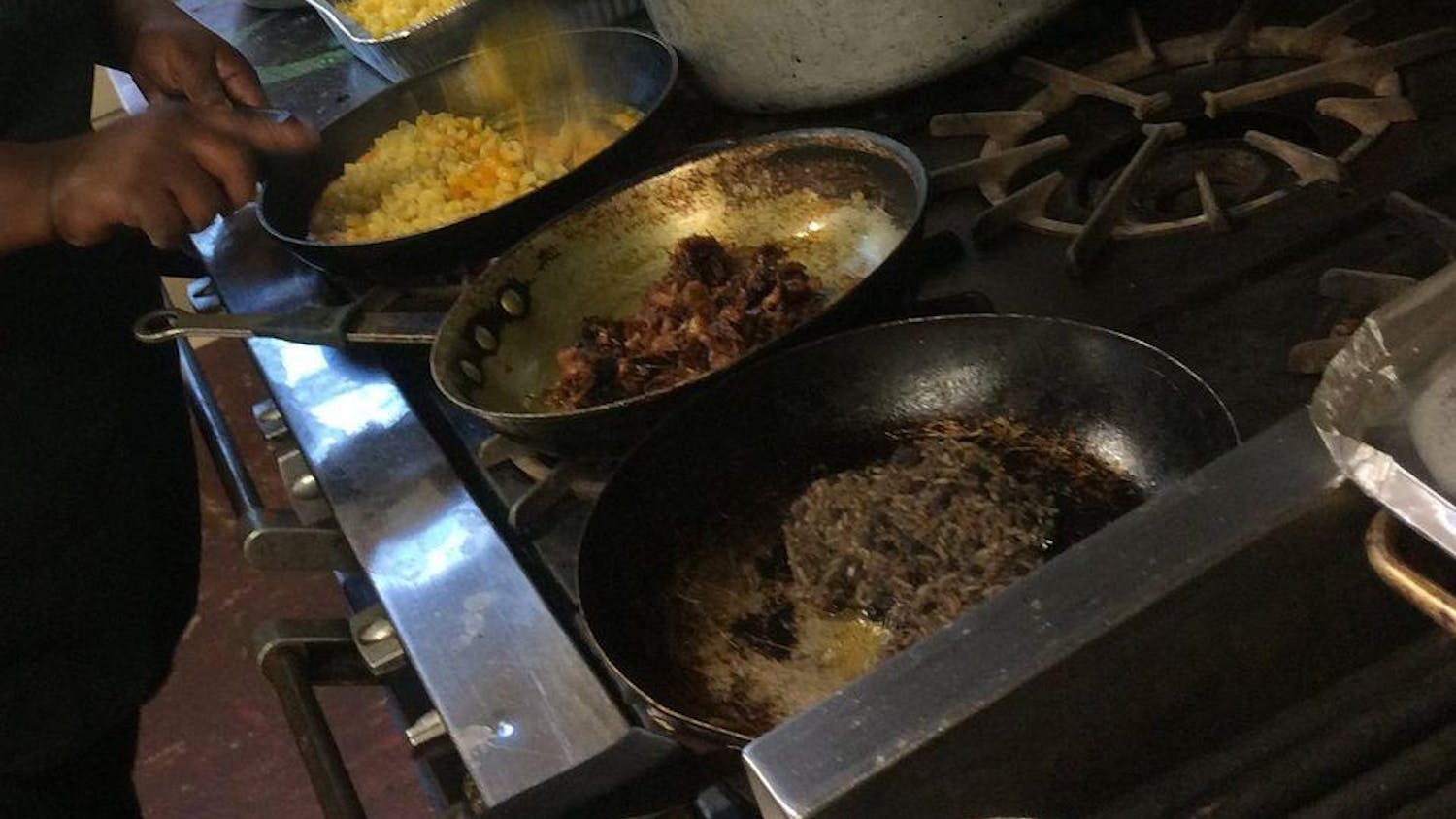Two weeks after the man in the midst of a campus controversy darted out of Franklin Hall and into a black Dodge Charger with vocal protesters laying in his path, more details of his seemingly secret visit have emerged. Some, including full budget details, are still unclear.
After Charles Murray’s speech April 11, it was talked about around IU. Protesters, supporters and listeners were grappling with how his speech and the implications of letting a speaker labeled a white nationalist by the Southern Poverty Law Center affected the campus. There is still an outstanding bill for the $6,771.39 cost of the 29 IUPD officers.
Murray’s speech brought in more than 300 protesters who chanted, and one even banged on a pot with a tire iron, as he spoke in President’s Hall, which is located in Franklin Hall and is the home of IU’s Media School.
The University did not sponsor, endorse or directly pay for Murray’s visit to campus, said Aurelian Craiutu, director of the Tocqueville Program that co-sponsored Murray’s talk with the American Enterprise Institute.
The Tocqueville Program brings politicians and scholars to campus.
The conservative Washington, D.C., think tank AEI paid Murray’s speaking fee. Two students, sophomore Katherine Hitchcock and senior Zach Montgomery, who lead AEI at IU, organized the speech. Despite its use of the University’s name, the executive council is not registered as an official student group. The students did not respond to requests for comment.
Murray’s general speaking fee falls somewhere between $20,001 and $30,000, according to All American Speakers, Murray’s booking agency.
Murray’s main purpose for visiting Indiana was to give his speech at IU, but he also met with AEI donors in Indianapolis during the trip, said Leslie Lenkowsky, who assists the Tocqueville program and is a retired IU-Purdue University Indianapolis professor.
Separately from AEI, Craiutu wanted Murray to visit as part of the Tocqueville lecture series on politics in the era of President Trump. When he realized it could happen through AEI, he reached out to Hitchcock and co-sponsored the event.
Originally the speech was scheduled to take place in Hodge Hall, Craiutu said. When police found out about the event, they decided too many classes would be disrupted and security would be easier to manage in Presidents Hall.
Police reached out to student organizers from AEI about 30 days before the speech to arrange security because of the violent protests at Murray’s speeches on other campuses like Middlebury College, said Superintendent of Public Safety Benjamin Hunter.
“IUPD’s decision to provide officers was based on our size, the expected crowd attending to protest and our need to ensure the safety of all attendees — speaker, participants and protesters,” Hunter said.
There were 70 officers from different departments in and around Franklin Hall the night of Murray’s speech. Officers from the Bloomington Police Department and Indiana State Police were also present.
ISP does not charge local departments for the services it provides, public information officer David Bursten said. IUPD’s bill is $6,771.39 for the 29 officers from the department and includes overtime and equipment rental, Hunter said.
IUPD will send an invoice to AEI to ask the think tank to pay, but if it does not, IUPD will pay the bill, Hunter said.
“We can never let cost drive a decision in our public safety planning,” Hunter said. “We need to make sure faculty, staff and students are always safe.”
Some of the protesters were critical of the number of officers at the event. Hunter said 70 officers were too many for the 300 protesters, but if there were 400 or 500, the 70 officers wouldn’t have been enough.
Charles Murray’s reputation was doomed by 82 words.
A single paragraph in the 1994 book “The Bell Curve” has earned the social scientist countless criticism, a cult following of protesters and the title of white nationalist, but the writing does not make any explicit claims.
His white nationalist label comes from the Southern Poverty Law Center, a nonprofit that works to protect civil rights. The SPLC is considered to be a legitimate resource by the FBI, which works with the organization to stop hate crimes, according to the FBI website.
“If the reader is now convinced that either the genetic or the environmental explanation has won out to the exclusion of the other, we have not done a sufficiently good job of presenting one side or the other,” Murray wrote in “The Bell Curve.” “It seems highly likely to us that both genes and the environment have something to do with racial differences. What might the mix be? We are resolutely agnostic on that issue; as far as we can determine, the evidence does not yet justify an estimate.”
Murray serves as a W. H. Brady Scholar at AEI.
Murray was on a speaking tour at colleges like Middlebury College, Villanova University and University of Notre Dame.
Murray disagreed with the label and published a blog post on the AEI website March 24 where he edited the SPLC’s page in the third person to correct some of the claims.
“Murray has written 13 full-length books,” he wrote on the post. “Only one of those books has discussed IQ and heritability. Are you sure you want to stick with ‘spent decades’?”
His relationship with race is more complex than labels make him seem. He fathered two children with his first wife Suchart Dej-Udom. His daughters, Narisara and Sarawan are American, Thai and Chinese.
The couple divorced, and Murray later married Catherine Cox before the release of “The Bell Curve.” When the book was published, he told the New York Times he worried it would bring threats of physical harm.
Even Cox opposed Murray’s politics when they first were together, but she said she saw his deep decency.
“He really cares about people,” Cox said in the Times article.
Inside Presidents Hall, about 60 sat and listened to Murray’s talk about his latest book “Coming Apart” that details the divide between upper-class and lower-class white America.
Before Murray’s visit, the IU webpage containing campus protest protocol changed. The online policy, which once said colleges and protests go together like peanut butter and jelly, still claims to support protesters. However, it now says on-campus events cannot be disrupted, whereas before it only mentioned University operations.
At the speech, listeners were given an “Indiana University Free Speech Rights and Responsibilities” half-sheet of paper. The front outlined the conditions of free speech at the event and said activities could not threaten the safety of community members, interfere with the University’s purpose or block entrances or exits to the building. The back side said students have the right to protest but speech attendees could ignore them.
“If you are approached by demonstrators and do not wish to engage in discussion with them, it’s advisable to refrain from provoking or ridiculing them,” it read.
Possibly the most notable aftermath of Murray’s visit was the anti-racist messages painted on Craiutu’s office and the glue that sealed its lock. An anonymous group posted about the vandalism on “It’s Going Down,” an online network that provides information and analysis on riots and strikes.
The post claims that while the protests were outside Franklin Hall, the group went to Craiutu’s office in Woodburn Hall. Craiutu did not want to comment on the vandalism.
It was posted on the website April 13, the day after a police report was filed with IUPD claiming vandalism in Woodburn Hall on Tuesday night.
“Whatever the reason for the invitation, we abhor it,” the post said. “While we have no faith in the university, we do think that public figures like Charles Murray and the institutions and people who support him should be confronted. But those confrontations do not always have to take place on terrain that is presented to us.”
The group responsible for the post said outrage at the small act of vandalism is laughable.
On the Thursday following Murray’s visit, the Political and Civil Engagement Program offered a discussion, “How Free Should Speech be at IU?” where campus leaders and professors spoke about the limits of free speech and the challenges it can present. The students from AEI at IU were not on the panel.
One week after Murray’s visit, the Hutton Honors College and IU Ethics Bowl organized a case study on free speech. Law Professor Steve Sanders presented on the legal and ethical boundaries IU faces when providing a forum to speakers. Students broke up into groups and analyzed bringing Charles Murray to campus from the perspective of different stakeholders including the administration, the protesters, the students and the media.
Also in the days following the Murray event, the Young Americans for Liberty at IU inflated a car-sized beach ball and invited students to write anything to celebrate free speech. Some chose curse words while others proclaimed their love of nachos. At least one writer saw the free speech ball as an opportunity to continue to raise issue with the handling of Murray’s event.
“IU curtails student rights when it surrounds Charles Murray with armed police,” the person had scribbled in black Sharpie on the yellow section of the ball.






